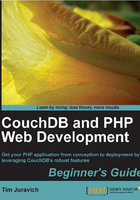
Introduction to CouchDB
For this book and for a variety of my own projects and startups, I chose CouchDB. Let's take a historical look at CouchDB, then quickly touch on its approach to the CAP theorem, and its strengths and weaknesses.
The history of CouchDB
In April 2005, Damien Katz posted a blog entry about a new database engine he was working on, later to be called CouchDB, which is an acronym for Cluster Of Unreliable Commodity Hardware. Katz, a former Lotus Notes developer at IBM, was attempting to create a fault-tolerant document database in C++, but soon after, shifted to the Erlang OTP platform. As months went by, CouchDB started to evolve under the self-funding of Damien Katz, and in February 2008, it was introduced to the Apache Incubator project. Finally, in November 2008, it graduated as a top-level project.
Damien's team, CouchOne, merged with the Membase team in 2011 to form a new company called Couchbase. This company was formed to merge CouchDB and Membase into a new product, and increase the documentation and visibility for the product.
In early 2012, Couchbase announced that it would be shifting focus from facilitating CouchDB and moving to create Couchbase Server 2.0. This new database takes a different approach to the database, which meant that it would not be contributing to the CouchDB community anymore. This news was met with some distress in the CouchDB community until Cloudant stepped in.
Cloudant, the chief CouchDB hosting company and creator of BigCouch, a fault tolerant and horizontally scalable clustering frameworking built for CouchDB, announced that they would merge their changes back to CouchDB, and take on the role of continuing development of CouchDB.
In early 2012, at the time of writing, CouchDB's most major release was 1.1.1 in March 31, 2011. But CouchDB 1.2 is looking to be released just around the corner!
Defining CouchDB
According to http://couchdb.apache.org/, CouchDB can be defined as:
- A document database server, accessible via a RESTful JSON API
- Ad-hoc and schema-free with a flat address space
- Distributed, featuring robust, incremental replication with bi-directional conflict detection and management
- Query-able and index-able, featuring a table oriented reporting engine that uses JavaScript as a query language.
You might be able to read between the lines, but CouchDB chose availability and partial-tolerance from the CAP theorem, and focuses on eventual consistency using replication.
We could go really deep into what each of these bullet points mean, because it will take the rest of the book until we've touched on them in depth. In each chapter, we'll begin to build on top of our CouchDB knowledge until we have a fully operational application in the wild.